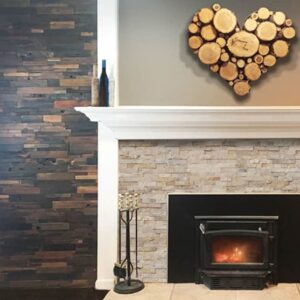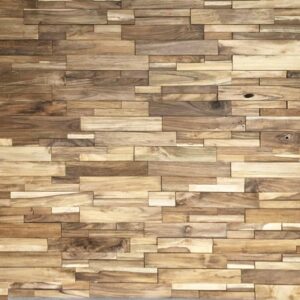3 results
Reclaimed wood panels carry whispers of history, stories from another time, and evidence of a life well-lived. Repurposed from old barns, warehouses, railway tracks, and other structures, these panels breathe new life into modern spaces, marrying rustic charm with contemporary aesthetics. Their unique textures, color variations, and imperfections add unparalleled character to homes. But where are these gems best showcased within the domestic space, and how does one ensure they continue to narrate their tales for years to come?
Where to Use Reclaimed Wood Panels
Feature Walls: One of the most popular uses of reclaimed wood panels is in creating stunning feature walls. A living room or bedroom wall adorned with these panels instantly becomes a focal point, radiating warmth and history.
Ceilings: For those looking to make a unique design statement, reclaimed wood panels on the ceiling can elevate the aesthetic of a room. It adds dimension and a touch of vintage charm overhead.
Flooring: While more intensive in terms of installation, reclaimed wood floors are breathtaking. Each plank tells a story, and together, they create a narrative tapestry underfoot.
Kitchen Islands and Cabinetry: The heart of the home, the kitchen, can benefit from the organic beauty of reclaimed wood. Panels can be used for the exterior of kitchen islands or as cabinet doors, infusing the space with warmth.
Bathroom Vanity: For a bathroom that stands out, consider using reclaimed wood panels for the vanity. Paired with modern fixtures, the juxtaposition can be both striking and harmonious.
Headboards: Create a bespoke headboard for your bed using reclaimed wood panels. It can be a simple, rustic design or a more intricate pattern, but it’s sure to be a conversation starter.
Doors: Interior sliding barn doors or even main doors made from reclaimed wood add character to the threshold of rooms and homes.
Caring for Reclaimed Wood Panels
Reclaimed wood, while robust and resilient, requires care to maintain its beauty and prolong its life. Here’s how you can cherish and protect these pieces of history:
- Regular Dusting: Dust and airborne particles can accumulate on the wood’s surface. Regularly dusting with a soft, dry cloth helps maintain its appearance.
- Avoid Excessive Moisture: While reclaimed wood has likely been exposed to various elements over the years, it’s essential to protect it from excessive moisture in its new setting. For panels in kitchens or bathrooms, ensure good ventilation and wipe off any standing water immediately.
- Use Gentle Cleaners: If you need to clean the wood beyond simple dusting, use a damp cloth and mild, wood-friendly cleaners. Avoid harsh chemicals or abrasive materials.
- Sealing or Finishing: Depending on where and how you’re using the reclaimed wood panels, consider applying a sealant or finish. This can protect the wood from stains, moisture, and daily wear and tear.
- Protect from Direct Sunlight: Prolonged exposure to direct sunlight can fade the wood’s color. If placed near windows, consider using curtains or blinds during peak sunlight hours.
- Embrace Imperfections: Remember, the beauty of reclaimed wood lies in its imperfections. Scratches, dents, or color variations all contribute to its character. Rather than trying to ‘fix’ these, embrace them as part of the wood’s history.
Reclaimed wood panels are more than just design elements; they are fragments of the past reintroduced into modern spaces. By incorporating them into various parts of the home and caring for them appropriately, homeowners can create interiors that resonate with history, warmth, and authenticity.


